英语语言学考研参考
- 格式:doc
- 大小:51.00 KB
- 文档页数:4
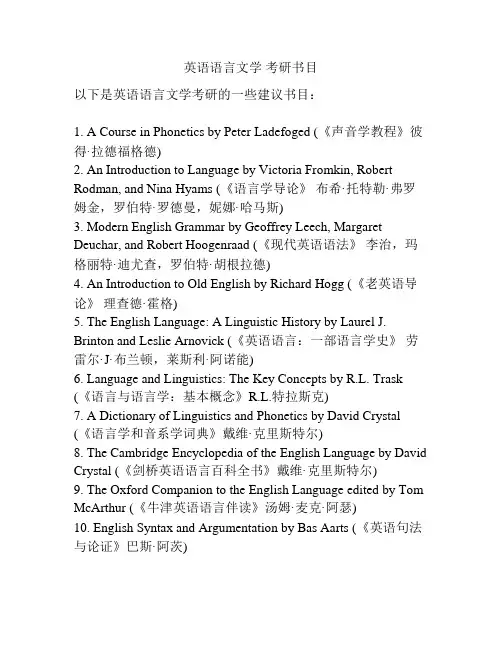
英语语言文学考研书目以下是英语语言文学考研的一些建议书目:1. A Course in Phonetics by Peter Ladefoged (《声音学教程》彼得·拉德福格德)2. An Introduction to Language by Victoria Fromkin, Robert Rodman, and Nina Hyams (《语言学导论》布希·托特勒·弗罗姆金,罗伯特·罗德曼,妮娜·哈马斯)3. Modern English Grammar by Geoffrey Leech, Margaret Deuchar, and Robert Hoogenraad (《现代英语语法》李治,玛格丽特·迪尤查,罗伯特·胡根拉德)4. An Introduction to Old English by Richard Hogg (《老英语导论》理查德·霍格)5. The English Language: A Linguistic History by Laurel J. Brinton and Leslie Arnovick (《英语语言:一部语言学史》劳雷尔·J·布兰顿,莱斯利·阿诺能)6. Language and Linguistics: The Key Concepts by R.L. Trask (《语言与语言学:基本概念》R.L.特拉斯克)7. A Dictionary of Linguistics and Phonetics by David Crystal (《语言学和音系学词典》戴维·克里斯特尔)8. The Cambridge Encyclopedia of the English Language by David Crystal (《剑桥英语语言百科全书》戴维·克里斯特尔)9. The Oxford Companion to the English Language edited by Tom McArthur (《牛津英语语言伴读》汤姆·麦克·阿瑟)10. English Syntax and Argumentation by Bas Aarts (《英语句法与论证》巴斯·阿茨)这些书籍涵盖了英语语言文学的不同方面,从语音学、语言学、语法到语言历史,都能提供必要的知识和理论基础。
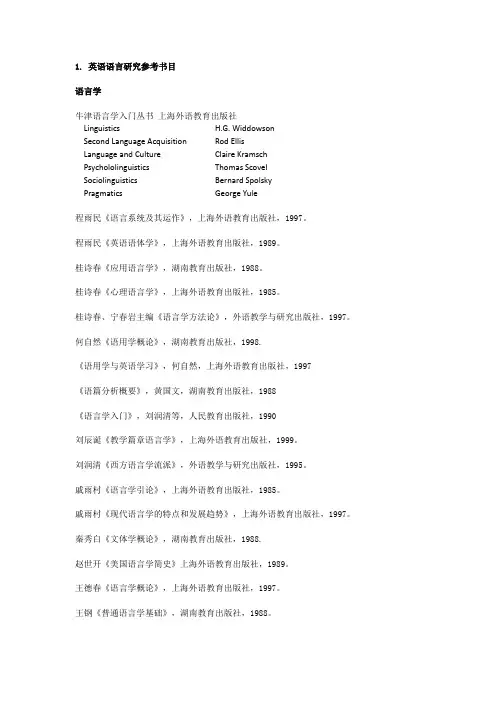
1. 英语语言研究参考书目语言学牛津语言学入门丛书上海外语教育出版社Linguistics H.G. WiddowsonSecond Language Acquisition Rod EllisLanguage and Culture Claire Kramsch Psychololinguistics Thomas ScovelSociolinguistics Bernard SpolskyPragmatics George Yule程雨民《语言系统及其运作》,上海外语教育出版社,1997。
程雨民《英语语体学》,上海外语教育出版社,1989。
桂诗春《应用语言学》,湖南教育出版社,1988。
桂诗春《心理语言学》,上海外语教育出版社,1985。
桂诗春、宁春岩主编《语言学方法论》,外语教学与研究出版社,1997。
何自然《语用学概论》,湖南教育出版社,1998.《语用学与英语学习》,何自然,上海外语教育出版社,1997《语篇分析概要》,黄国文,湖南教育出版社,1988《语言学入门》,刘润清等,人民教育出版社,1990刘辰诞《教学篇章语言学》,上海外语教育出版社,1999。
刘润清《西方语言学流派》,外语教学与研究出版社,1995。
戚雨村《语言学引论》,上海外语教育出版社,1985。
戚雨村《现代语言学的特点和发展趋势》,上海外语教育出版社,1997。
秦秀白《文体学概论》,湖南教育出版社,1988.赵世开《美国语言学简史》上海外语教育出版社,1989。
王德春《语言学概论》,上海外语教育出版社,1997。
王钢《普通语言学基础》,湖南教育出版社,1988。
王宗炎《语言学和语言的运用》,上海外语教育出版社,1998。
王宗炎《语言问题探索》,上海外语教育出版社,1985。
伍谦光《语义学导论》,湖南教育出版社,1988。
杨自俭、李瑞华《英汉对比研究论文集》,上海外语教育出版社,1990。
祝畹瑾《社会语言学概论》,湖南教育出版社,1992。
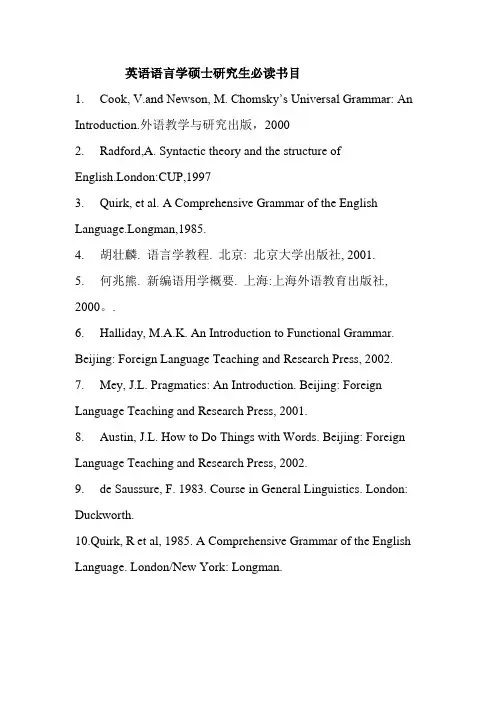
英语语言学硕士研究生必读书目1. Cook, V.and Newson, M. Chomsky’s Universal Grammar: An Introduction.外语教学与研究出版,20002. Radford,A. Syntactic theory and the structure ofEnglish.London:CUP,19973. Quirk, et al. A Comprehensive Grammar of the English Language.Longman,1985.4. 胡壮麟. 语言学教程. 北京: 北京大学出版社, 2001.5. 何兆熊. 新编语用学概要. 上海:上海外语教育出版社, 2000。
.6. Halliday, M.A.K. An Introduction to Functional Grammar. Beijing: Foreign Language Teaching and Research Press, 2002.7. Mey, J.L. Pragmatics: An Introduction. Beijing: Foreign Language Teaching and Research Press, 2001.8. Austin, J.L. How to Do Things with Words. Beijing: Foreign Language Teaching and Research Press, 2002.9. de Saussure, F. 1983. Course in General Linguistics. London: Duckworth.10.Quirk, R et al, 1985. A Comprehensive Grammar of the English Language. London/New York: Longman.11.Joseph, G. MLA Handbook for Writers of Research Papers(5th edition). Shanghai: Shanghai Foreign Language Education Press, 2001.12.朱刚:《二十世纪西方文艺批评理论》(英文),上海外语教育出版社,2001;13.刘炳善:《英国文学简史》(英文),郑州:河南人民出版社;14.常耀信:《美国文学简史》(英文),天津:南开大学出版社;15.文学方向必读期刊:Critical Inquiry, published by the University of Chicago; New Literary History, published by the Johns Hopkins University Press; Comparative Literature, published by University of Oregon;《外国文学评论》、《外国文学研究》、《外国文学》、《国外文学》、《当代外国文学》或其他与外国文学相关的核心期刊。
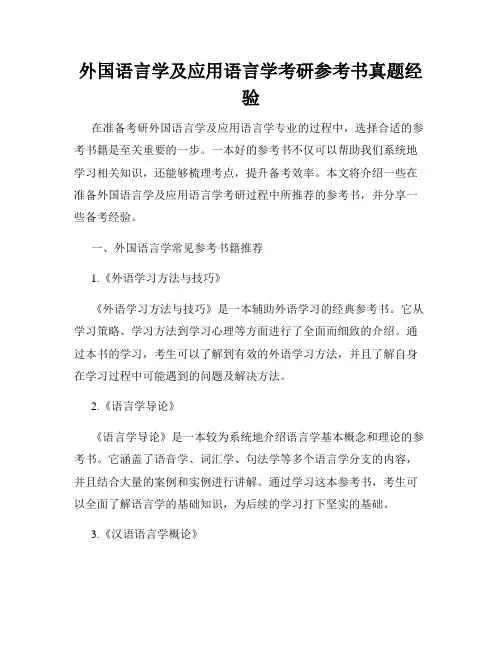
外国语言学及应用语言学考研参考书真题经验在准备考研外国语言学及应用语言学专业的过程中,选择合适的参考书籍是至关重要的一步。
一本好的参考书不仅可以帮助我们系统地学习相关知识,还能够梳理考点,提升备考效率。
本文将介绍一些在准备外国语言学及应用语言学考研过程中所推荐的参考书,并分享一些备考经验。
一、外国语言学常见参考书籍推荐1.《外语学习方法与技巧》《外语学习方法与技巧》是一本辅助外语学习的经典参考书。
它从学习策略、学习方法到学习心理等方面进行了全面而细致的介绍。
通过本书的学习,考生可以了解到有效的外语学习方法,并且了解自身在学习过程中可能遇到的问题及解决方法。
2.《语言学导论》《语言学导论》是一本较为系统地介绍语言学基本概念和理论的参考书。
它涵盖了语音学、词汇学、句法学等多个语言学分支的内容,并且结合大量的案例和实例进行讲解。
通过学习这本参考书,考生可以全面了解语言学的基础知识,为后续的学习打下坚实的基础。
3.《汉语语言学概论》《汉语语言学概论》是一本介绍汉语语言学理论和研究方法的参考书。
它系统地讲解了汉语语音、汉语词汇、汉语句法等方面的知识,并且结合大量的实例进行解析。
通过学习这本教材,考生可以对汉语语言学有一个较为全面的了解。
二、应用语言学常见参考书籍推荐1.《应用语言学导论》《应用语言学导论》是一本介绍应用语言学理论和研究方法的参考书。
它包括了语言教学、语言测试、翻译和语言政策等方面的内容,并且对相关的理论进行了详细的解释和讨论。
通过学习这本教材,考生可以了解应用语言学的基本概念和研究方法,并且了解其在实际应用中的重要性。
2.《翻译学概论》《翻译学概论》是一本介绍翻译学理论和实践的参考书。
它详细介绍了翻译的概念、原则以及翻译过程中可能遇到的问题和解决方法。
通过学习这本教材,考生可以了解翻译学的基本理论,并且提升自己的翻译能力。
三、备考经验分享1.制定合理的学习计划在备考过程中,我们应该制定一个合理的学习计划。
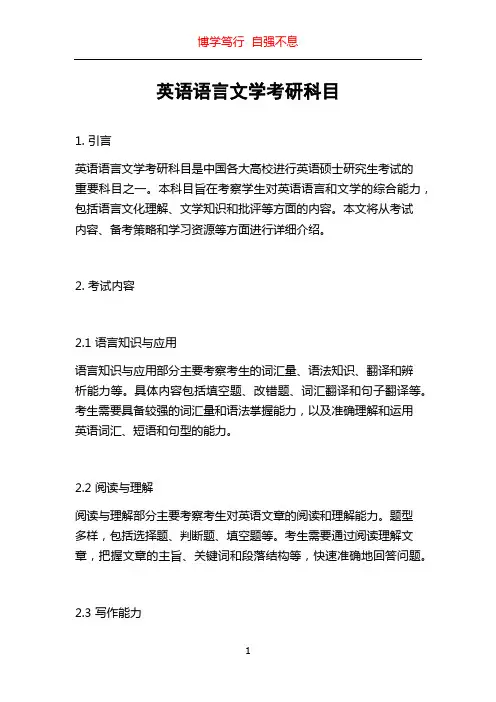
英语语言文学考研科目1. 引言英语语言文学考研科目是中国各大高校进行英语硕士研究生考试的重要科目之一。
本科目旨在考察学生对英语语言和文学的综合能力,包括语言文化理解、文学知识和批评等方面的内容。
本文将从考试内容、备考策略和学习资源等方面进行详细介绍。
2. 考试内容2.1 语言知识与应用语言知识与应用部分主要考察考生的词汇量、语法知识、翻译和辨析能力等。
具体内容包括填空题、改错题、词汇翻译和句子翻译等。
考生需要具备较强的词汇量和语法掌握能力,以及准确理解和运用英语词汇、短语和句型的能力。
2.2 阅读与理解阅读与理解部分主要考察考生对英语文章的阅读和理解能力。
题型多样,包括选择题、判断题、填空题等。
考生需要通过阅读理解文章,把握文章的主旨、关键词和段落结构等,快速准确地回答问题。
2.3 写作能力写作能力部分主要考察考生的写作表达能力和文化背景等。
题型包括议论文、短文写作和书信写作等。
考生需要具备良好的写作能力,包括组织结构清晰、逻辑严密、语言准确的能力。
2.4 英美文学及文化英美文学及文化部分主要考察考生对英美文学和文化的了解和理解。
题型包括选择题、判断题和简答题等。
考生需要熟悉英美文学经典作品和重要文化事件,具备对文学作品进行分析和批评的能力。
3. 备考策略3.1 合理规划备考英语语言文学考研科目需要合理规划复习时间和内容。
可以根据自己的实际情况,制定每天的复习计划,包括复习语言知识、阅读与理解、写作和英美文学等内容。
3.2 多维学习备考中应采取多维学习的方式,包括听力、阅读、口语和写作等方面。
可以通过听力材料、阅读文章、口语练习和写作训练等提高综合能力。
3.3 频繁练习备考过程中需要进行频繁的练习,包括做真题、模拟试题和自主练习等。
通过大量的练习,可以提高解题速度和准确率,也可以发现自己的不足之处。
4. 学习资源4.1 教材和参考书籍备考英语语言文学考研科目可以选择相应的教材和参考书籍进行学习。
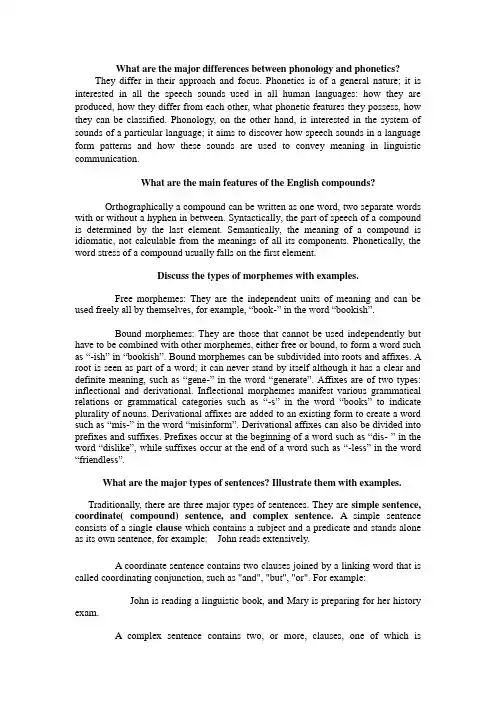
What are the major differences between phonology and phonetics?They differ in their approach and focus. Phonetics is of a general nature; it is interested in all the speech sounds used in all human languages: how they are produced, how they differ from each other, what phonetic features they possess, how they can be classified. Phonology, on the other hand, is interested in the system of sounds of a particular language; it aims to discover how speech sounds in a language form patterns and how these sounds are used to convey meaning in linguistic communication.What are the main features of the English compounds?Orthographically a compound can be written as one word, two separate words with or without a hyphen in between. Syntactically, the part of speech of a compound is determined by the last element. Semantically, the meaning of a compound is idiomatic, not calculable from the meanings of all its components. Phonetically, the word stress of a compound usually falls on the first element.Discuss the types of morphemes with examples.Free morphemes: They are the independent units of meaning and can be used freely all by themselves, for example, “book-” in the word “bookish”.Bound morphemes: They are those that cannot be used independently but have to be combined with other morphemes, either free or bound, to form a word such as “-ish” in “bookish”. Bound morphemes can be subdivided into roots and affixes. A root is seen as part of a word; it can never stand by itself although it has a clear and d efinite meaning, such as “gene-” in the word “generate”. Affixes are of two types: inflectional and derivational. Inflectional morphemes manifest various grammatical relations or grammatical categories such as “-s” in the word “books” to indicate plurality of nouns. Derivational affixes are added to an existing form to create a word such as “mis-” in the word “misinform”. Derivational affixes can also be divided into prefixes and suffixes. Prefixes occur at the beginning of a word such as “dis- ” in the wor d “dislike”, while suffixes occur at the end of a word such as “-less” in the word “friendless”.What are the major types of sentences? Illustrate them with examples.Traditionally, there are three major types of sentences. They are simple sentence, coordinate( compound) sentence, and complex sentence. A simple sentence consists of a single clause which contains a subject and a predicate and stands alone as its own sentence, for example: John reads extensively.A coordinate sentence contains two clauses joined by a linking word that is called coordinating conjunction, such as "and", "but", "or". For example:John is reading a linguistic book, and Mary is preparing for her history exam.A complex sentence contains two, or more, clauses, one of which isincorporated into the other. The two clauses in a complex sentence do not have equal status, one is subordinate to the other. For example: Before John gave her a lecture, Mary showed no interest in linguistics.Are the elements in a sentence linearly structured? Why?No. Language is both linearly and hierarchically structured. When a sentence is uttered or written down, the words of the sentence are produced one after another in a sequence. A closer examination of a sentence shows that a sentence is not composed of sequence of words arranged in a simple linear order with one adding onto another following a simple arithmetic logic. In fact, sentences are also hierarchically structured. They are organized by grouping together words of the same syntactic category, such as noun phrase (NP) or verb phrase (VP).How do you distinguish between entailment and presupposition in terms oftruth values?Entailment is a relation of inclusion. Suppose there are two sentences X and Y: X: He has been to France.Y: He has been to Europe.In terms of truth values, if X is true, Y is necessarily true, e.g. If he has been to France, he must have been to Europe.If X is false, Y may be true or false, e. g. If he has not been to France, he may still have been to Europe or he has not been to Europe. If Y is true, X may be true or false, e.g. If he has been to Europe, he may or may not have been to France.If Y is false, X is false, e.g. If he has not been to Europe, he cannot have been to France.Therefore we conclude that X entails Y or Y is an entailment of X.The truth conditions that we use to judge presupposition is as follows:Suppose there are two sentences X and YX: John' s bike needs repairing.Y: John has a bike.If X is true, Y must be true, e.g. If John' s bike needs repairing, John must have a bike.If X is false, Y is still true, e. g. If John' s bike does not need repairing, John still has a bike. If Y is true, X is either true or false, e.g. If John has a bike, it may or may not need repairing. If Y is false, no truth value can be said about X, e.g. If John does not have a bike, nothing can be said about whether his bike needs repairing or not. Therefore, X presupposes Y, or Y is a presupposition of X.How are semantics and pragmatics different from each other?Traditional semantics studied meaning, but the meaning of language was considered as something intrinsic, and inherent, i.e. a property attached to language itself. Therefore, meanings of words, meanings of sentences were all studied in an isolated manner, detached from the context in which they were used. Pragmatics studies meaning not in isolation, but in context. The essential distinction between semantics and pragmatics is whether the context of use is considered in the study of meaning . If it is not considered, the study is restricted to the area of traditional semantics; if it is considered, the study is being carried out in the area of pragmatics.How does a sentence differ from an utterance?A sentence is a grammatical concept. It usually consists of a subject and predicate. An utterance is the unit of communication. It is the smallest linguistic unit that has a communicative value. If we regard a sentence as what people actually utter in the course of communication, it becomes an utterance. Whether “Mary is beautiful.” is a sentence or an utterance de pends on how we look at it. If we regard it as a grammatical unit or a self-contained unit in isolation, then it is a sentence. If we look at it as something uttered in a certain situation with a certain purpose, then it is an utterance. Most utterances take the form of complete sentences, but some utterances are not, and some cannot even be restored to complete sentences.How does a sentence meaning differ from an utterance meaning?A sentence meaning is often considered as the intrinsic property of the sentence itself in terms of a predication. It is abstract and independent of context. The meaning of an utterance is concrete, and context-dependent. The utterance meaning is based on sentence meaning; it is realization of the abstract meaning of a sentence in a real situation of communication, or simply in a context. For example, “There is a dog at the door”. The speaker could utt er it as a matter- of- fact statement, telling the hearer that the dog is at the door. The speaker could use it as a warning, asking the hearer not to approach the door. There are other possibilities, too. So, the understanding of the utterance meaning of “There is a dog at the door” de pends on the context in which it is uttered and the purpose for which the speaker utters it.As language changes over time, the meaning of a word may deviate from its original denotation. Discuss the major types of semantic changes.Major types of semantic changes are semantic broadening, semantic narrowing and semantic shift.Semantic broadening refers to the process in which the meaning of a word becomes more general or inclusive than its historically earlier denotation. Take the word "holiday" for example, The older meaning was a " holy day." Today everyone enjoys a holiday, whether he or she is religious or not.Semantic narrowing is a process in which the meaning of a word becomes less general or inclusive than its historically earlier meaning. For example, " wife," used to mean "any woman," but now it means “married females” only.Semantic shift is a process of semantic change in which a word loses its former meaning and acquires a new, sometimes related, meaning.For example, the word silly meant “happy” in Old English, and naive in Middle English, but "foolish" in Modern English.What are the causes of language change? Discuss them in detail.Language changes are due to the following causes:1) Sound assimilation: Sound assimilation refers to the physiological effect of one sound on another. In an assimilative process, successive sounds are made identical, or more similar, to one another in terms of place or manner of articulation, or of haplology, the loss of one of two phonetically similar syllables in sequence. For example, the Old English word "Engla-land" ("the land of the Angles") came to be pronounced “England” through the assimilation of "la-la sounds.2) Rule simplification and regularization:Some changes are the result of simplification and regularization. The plural forms of borrowed words are usually irregular, thus complex. For example, the plural forms of "agendum", "datum", "curriculum" and "memorandum" are "agenda" , "data" , "curricula" and "mem-oranda" . The irregular plurals of these nouns have been replaced by regular plurals of "agendas", "curriculums", and "memorandums" among many speakers, thus making them simplified and regularized.3) Internal borrowing: In order to reduce the number of exceptional or irregular morphemes, speakers of a particular language may borrow a rule from one part of the grammar and apply it generally. For example, by analogy to the plural formation of "foe-s" and "dog-s", speakers started saying "cows" as the plural of "cow" instead of the earlier plural kine.4) Elaboration: Rule elaboration occurs when there is a need to reduce ambiguity and increase communicative clarity or expressiveness. If a particular grammatical feature is lost as a result of a change in the phonological system, some other feature may be added in another component of the grammar.5) Social triggers: Socio-political changes such as wars, invasions, occupation, colonization, and language planning and standardization policies lead to language changes. For example, in the history of English, the Norman Conquest marked the beginning of the Middle English period. And British colonial settlement, and the country' s political, cultural and economic advances in distant lands such as North America, Oceania, South Africa, and India lead to the change of English into British, American, Australian, South African and Indian varieties.6) Cultural transmission:Although a new generation has to find a way of using the language of the previous generation, it has to find expressions that can best communicate the views and concepts of the time and the changed and ever-changing social life, and re-create the language of the community. For example, while old people tend to call a refrigerator "icebox," the younger generation is more often heard speaking of a "fridge." This tenuous transmission process adds up to the inevitable and ongoing language change and variation.7) Children's approximation toward the adult grammar:The way children acquire the language is another basic cause for language change. Children usually construct their personal grammars by themselves and generalize rules from the linguistic information they hear. Children' s grammar never models exactly after that of the adult speech community, because children are exposed to diverse linguistic information.All the above factors contribute to language changes.What are the biological foundations of language?Of all organisms, human beings are the only spontaneous creators and users of highly sophisticated languages that permit the communication of a wide range of knowledge and ideas. Evidently, our linguistic ability does not depend primarily on the structure of our vocal cords, for other mammals also have vocal cords. Human linguistic ability largely depends, instead, on the structure and dynamics of the human brain. As far as is currently known, human beings are the only organisms in which one particular part of the left half of the brain is larger than the corresponding part of the right half. This has led to the belief that human language is biologically, or more exactly, neurologically, based.How are language and thought related to each other?Language and thought may be viewed as two independent circles overlapping in some parts, where language and thought are consistent with each other and one never occurs without the other. When language and thought are identical or closely parallel to each other, we may regard thought as "subvocal speech”, and speech as "overt thought. In such a case, speaking and thinking take place simultaneously.What's the difference between acquisition and learning, according toKrashen?According to Krashen, acquisition refers to the gradual and subconscious development of ability in the first language by using it naturally in daily communicative situations. Learning, however, is defined as a conscious process of accumulating knowledge of a second language usu-ally obtained in school settings. A second language, Krashen argues, is more commonly learned but to some degree may also be acquired, depending on the environmental setting and the input received by the L2 learner. A rule can be learned before it is internalized (i.e., acquired), but having learned a rule does not necessarily prevent having to acquire it later. For example, an English language learner may have learned a rule like the third person singular "-s", but is unable to articulate the correct form in casual and spontaneous conversation because the rule has not yet been acquired. This shows that conscious knowledge of rules does not ensure an immediate guidance for actual performance.How do the learner factors potentially influence the way in which a secondlanguage is acquired?1) The optimum age for second language acquisition: First language acquisition is most successful when it occurs during the early years of one' s life before puberty, but the optimum age for SLA does not always accord with the maxim of "the younger the better". The optimum age for SLA is early teenage. This claim is justifiable because this is the age when the learner' s flexibility of the language acquisitionfaculty has not been completely lost while one's cognitive skills have developed considerably.2) Motivation: Motivation in language learning can be defined in terms of the learner’s overall goal or orientation. Instrumental motivation occurs when the learner's goal is functional, and integrative motivation occurs when the learner's goal is social. If the target language functions as a foreign language (used in a limited environment such as in school), the learner is likely to benefit from an integrative motivation; but if the target language functions as a second language (used as a primary means of communication in the community of the learner), an instrumental motivation is more effective.3) Acculturation: The acculturation hypothesis focuses on the social and psychological conditions under which L2 processing is most likely to take place successfully. It states simply that the more a person aspires to acculturate to the community of the target language, the further he or she will progress along the developmental continuum.4) Personality: Intuitively, an outgoing personality may contribute to language acquisition. Research results, however, only partially support this hypothesis. No significant relationship has been found between talkativeness on the one hand and overall proficiency in a second language on the other. But it is recognized that as a result of being frequently exposed to and interacting with the target language, learners with an extroverted personality are likely to achieve better oral fluency than otherwise.In sum, A good second language learner is, among other things, an adolescent who has a strong and well-defined motivation to learn. He is able to respond and adaptable to different learning situations. He seeks out all opportunities and makes maximum use of them to interact with the input. He employs appropriate learning strategies. And he is willing to identify himself or herself with the culture of the target language community.What is the role of input for SLA?It is evident that SLA takes place only when the learner has access to L2 input and the opportunity to interact with the input. It appears that what learners need is not mere exposure to L2 data, but the kind of input data that are specially suited to their current stage of development. There is, however, no agreement as to precisely what constitutes optimum input. Some scholars advise that access to comprehensible input is a necessary condition for acquisition to take place. It is suggested that input can be made comprehensible by the use of learned structures and vocabulary, the linguistic and extralinguistic contexts of the input data, and the learner's general knowledge to interpret new language items. It is also suggested that interaction (i.e. , taking part in communicative activities) and intake (i.e. , the input that is assimilated and fed into the interlanguage system) are more important for SLA than input.Discuss the contrastive analysis in detail.Contrastive Analysis was developed in order to identify and predict the areasof learning difficulty. Given this approach, it was hypothesized that L2 errors were predominantly the result of negative transfer, or mother tongue interference and second language learning was believed to be a matter of overcoming the differences between LI and L2 systems.According to this view, the major task of second language teaching should predominantly be: first, contrast the native and the target language systems and make predictions about the language items that would cause difficulty and the errors that learners were likely to make; then use these predictions in deciding on the type of language items that needed special treatment in teaching and in material development and the type of intensive techniques that would be employed to overcome learning difficulties created by the interference.In practice, the Contrastive Analysis is not effective because a large proportion of grammatical errors could not be explained by mother tongue interference. Errors predicted by contrastive analysis have often not occurred, whereas many actual errors, such as "goed" and "foots", come from overgeneralization instead of negative transfer.Errors, according to the contrastive analysis approach, are negative and had to be overcome or given up. In fact, errors produced in a learner's second language utterance may very well be developmental errors and therefore, should not be looked upon simply as a failure to learn the correct form, but as an indication of the actual acquisition process in action. Developmental errors often result from the effort on the part of the learner to construct and test general rules of communication in the target language.Why do we say language acquisition is primarily the acquisition of thegrammatical system of language?In principle, no human brain can store all the words and expressions of a language. What happens is that when processing the language they hear, children construct the grammar and make sense of the expressions according to the grammar. When producing utterances, they follow the internalized grammatical rules. Without the knowledge of the productive rules, it would be impossible for language users to produce and understand an unlimited number of sentences which they have never heard before.Discuss the biological basis of language acquisition.Language acquisition is a genetically determined capacity that all humans possess. Although the development of a communicative system is not unique to human beings, the natural acquisition of language as a system of highly abstract rules and regulations for creative communication distinguishes humans from all other animal species. In this sense, humans can be said to be predisposed, that is, biologically programmed, to acquire at least one language. Language development can thus be regarded as analogous to other biological developments in human growth and maturation, such as the growth and maturation of one’s limbs and organs. Humans are equipped with the neural prerequisites for language and language use, just as birds are biologically “prewired” to learn the songs of their species.What is the role of imitation in first language acquisition?At one time, it was widely believed that children learned language by simply imitating the speech of those around them. We now know that this cannot be true, since many utterance types produced by children do not closely resemble structures found in adult speech. . If children learn their native tongue by imitating their parents, how can we account for the utterances that are typical of children' s language, such as the plural form "my foots," the past tense forms of " I eated," and the negative construction of “No the sun shining”? It is impossible that children imitate these structures from adults because they are never heard in adult conversations. In addition, Children with speech impairment for neurological or physiological reasons learn the language spoken to them and understand what is said.A more reasonable explanation is that children are attempting to construct and generalize their own grammatical rules.Some young language learners do seem to make selective use of imitation, but they do not blindly mimic adult speech in a parrot fashion, but rather exploit it in very restricted ways to improve their linguistic skills. The point is that imitation plays at best a very minor role in the child' s mastery of language.What is the role of correction in first language acquisition?。
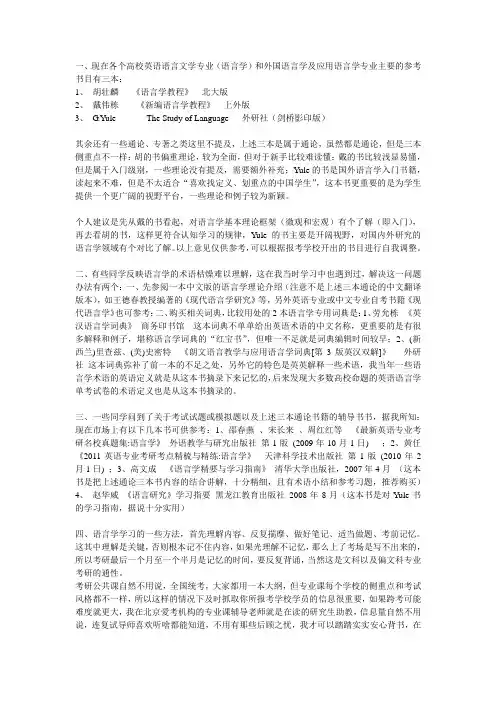
一、现在各个高校英语语言文学专业(语言学)和外国语言学及应用语言学专业主要的参考书目有三本:1、胡壮麟《语言学教程》北大版2、戴伟栋《新编语言学教程》上外版3、G.Yule The Study of Language 外研社(剑桥影印版)其余还有一些通论、专著之类这里不提及,上述三本是属于通论,虽然都是通论,但是三本侧重点不一样:胡的书偏重理论,较为全面,但对于新手比较难读懂;戴的书比较浅显易懂,但是属于入门级别,一些理论没有提及,需要额外补充;Yule的书是国外语言学入门书籍,读起来不难,但是不太适合“喜欢找定义、划重点的中国学生”,这本书更重要的是为学生提供一个更广阔的视野平台,一些理论和例子较为新颖。
个人建议是先从戴的书看起,对语言学基本理论框架(微观和宏观)有个了解(即入门),再去看胡的书,这样更符合认知学习的规律,Y ule的书主要是开阔视野,对国内外研究的语言学领域有个对比了解。
以上意见仅供参考,可以根据报考学校开出的书目进行自我调整。
二、有些同学反映语言学的术语枯燥难以理解,这在我当时学习中也遇到过,解决这一问题办法有两个:一、先参阅一本中文版的语言学理论介绍(注意不是上述三本通论的中文翻译版本),如王德春教授编著的《现代语言学研究》等,另外英语专业或中文专业自考书籍《现代语言学》也可参考;二、购买相关词典,比较用处的2本语言学专用词典是:1、劳允栋《英汉语言学词典》商务印书馆这本词典不单单给出英语术语的中文名称,更重要的是有很多解释和例子,堪称语言学词典的“红宝书”,但唯一不足就是词典编辑时间较早;2、(新西兰)里查兹、(美)史密特《朗文语言教学与应用语言学词典[第3版英汉双解]》外研社这本词典弥补了前一本的不足之处,另外它的特色是英英解释一些术语,我当年一些语言学术语的英语定义就是从这本书摘录下来记忆的,后来发现大多数高校命题的英语语言学单考试卷的术语定义也是从这本书摘录的。
三、一些同学问到了关于考试试题或模拟题以及上述三本通论书籍的辅导书书,据我所知:现在市场上有以下几本书可供参考:1、邵春燕、宋长来、周红红等《最新英语专业考研名校真题集:语言学》外语教学与研究出版社第1版(2009年10月1日) ;2、黄任《2011英语专业考研考点精梳与精练:语言学》天津科学技术出版社第1版(2010年2月1日) ;3、高文成《语言学精要与学习指南》清华大学出版社,2007年4月(这本书是把上述通论三本书内容的结合讲解,十分精细,且有术语小结和参考习题,推荐购买)4、赵华威《语言研究》学习指要黑龙江教育出版社2008年8月(这本书是对Y ule书的学习指南,据说十分实用)四、语言学学习的一些方法,首先理解内容、反复揣摩、做好笔记、适当做题、考前记忆。

「考研」英语专业考研参考书单「考研」英语专业考研参考书单外国语言学及应用语言学考研参考书推荐1.《语言学教程(第四版)》,胡壮麟主编,北京大学出版社.2.《现代语言学》,何兆熊梅德明主编,外语教学与研究出版社.3.《新编语言学教程(第1版)》,刘润清文旭编著,外语教学与研究出版社.5. Linguistics: an Introduction to Language and Communication (the 5th edition). AdrianAkmajian;Richard A. Derners;Ann K. Farmer;Robert M. Harnish编著,外语教学与研究出版社.6.《语言学高级教程》,胡壮麟姜望琪主编,北京大学出版社.7.《语言研究》(Second Edition),George Yule,外语教学与研究出版社/剑桥大学出版社.8.《语言学入门》,Poole, S.C. ,外语教学与研究出版社.9.《胡壮麟语言学教程笔记和考研真题详解》,中国石化出版社翻译专业考研参考书推荐1.《英汉翻译根底教程》,冯庆华穆雷主编,高等教育出版社.2.《翻译研究词典》,谭载喜主译,外语教学与研究出版社.3.《英汉互译实用教程》,郭著章李庆生著,武汉大学出版社.4.《实用英汉翻译教程》,申雨平等编,外语教学与研究出版社.5.《英汉翻译简明教程》,庄绎传著,外语教学与研究出版社.商务英语专业考研参考书推荐1.《国际贸易》,薛荣久著,对外经济贸易大学出版社.2.《国际商务》(英文版) Michael R. Czinkota, 7th edition,中国机械工业出版社.3.《商务英语写作》, 李细著, 清华大学出版社.4.《商务英语翻译》, 汤静芳著, 对外经济贸易大学出版社.5.《商务英语入门(修订版)》,任书梅王璐主编, 外语教学与研究出版社.6.《国际贸易实务(英文版)》,谢桂梅编著, 清华大学出版社.文学专业考研参考书推荐1.《英国文学简史》,常耀信,南开大学出版社.2.《美国文学简史》,常耀信,南开大学出版社.3.《英国文学简史:学习指南》(常耀信版《英国文学简史》配套辅导),赵红英编,西南交通大学出版社.4.《美国文学简史:学习指南(第3版)》配套南开大学常耀信版,赵红英编,西南交通大学出版社.5.《英国文学选读》,王守仁,高等教育出版社.6.《美国文学选读》,陶洁,高等教育出版社.7.《英国文学简史》(普通高等教育十一五国家级规划教材),刘炳善,河南人民出版社.8.《英语专业考研英美文学考点测评/北京环球时代学校英语专业考研点睛丛书》,世界图书出版公司.英语教学方向/课程与教学论专业考研参考书推荐1.《语言教学的流派(第二版)》, Jack C. Richards,Theodore S. Rodgers,外语教学与研究出版社/剑桥大学出版社.2.《第二语言教与学》, David Nunan,外语教学与研究出版社.3.《语言学习与语言教学的原那么》(Third Edition),H.D. Brown, 外语教学与研究出版社.4.《教育学》,王道俊王汉澜著,人民教育出版社.5.《简明中国教育史》,王炳照等著,北京师范大学出版社.6.《中国教育史》(修订本),孙培青主编,华东师范大学出版社.7.《外国教育史教程》,吴式颖著,人民教育出版社.8.《教育研究方法论初探》,叶澜著,上海教育出版社.9.《教育研究方法》,袁振国著,高等教育出版社.10.《当代教育心理学》,陈琦刘儒德主编,北京师范大学出版社.备注:以上阅读书目是我系英语专业教研室在系务委员会的'指导下,精心挑选的书单,供英语专业考研学生参考阅读。
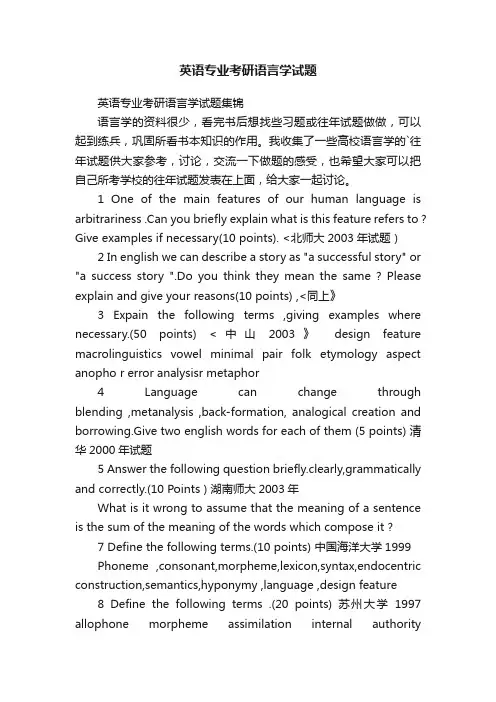
英语专业考研语言学试题英语专业考研语言学试题集锦语言学的资料很少,看完书后想找些习题或往年试题做做,可以起到练兵,巩固所看书本知识的作用。
我收集了一些高校语言学的`往年试题供大家参考,讨论,交流一下做题的感受,也希望大家可以把自己所考学校的往年试题发表在上面,给大家一起讨论。
1 One of the main features of our human language is arbitrariness .Can you briefly explain what is this feature refers to ? Give examples if necessary(10 points). <北师大2003年试题)2 In english we can describe a story as "a successful story" or "a success story ".Do you think they mean the same ? Please explain and give your reasons(10 points) ,<同上》3 Expain the following terms ,giving examples where necessary.(50 points) <中山2003》design feature macrolinguistics vowel minimal pair folk etymology aspect anopho r error analysisr metaphor4 Language can change through blending ,metanalysis ,back-formation, analogical creation and borrowing.Give two english words for each of them (5 points) 清华2000年试题5 Answer the following question briefly.clearly,grammatically and correctly.(10 Points ) 湖南师大2003年What is it wrong to assume that the meaning of a sentence is the sum of the meaning of the words which compose it ?7 Define the following terms.(10 points) 中国海洋大学1999Phoneme ,consonant,morpheme,lexicon,syntax,endocentric construction,semantics,hyponymy ,language ,design feature8 Define the following terms .(20 points) 苏州大学1997 allophone morpheme assimilation internal authorityinterlanguage phatic communionclosed-class word government semantica triangic lingua francaWhat is the main grammatical difference between a sentence and a clause ? 同上6 Translate into chinese and exemplify each of the following.(10 points )Example : dialectal synonymsAnswer , 方言同义词,Fall and autumn are dialectal synonyms .homography homophony gradable opposites endocentric constuctionexocentric construction9 大连外国语学院1992年语言学全部试题 100 POINTSList the six important characteristics of human language .What are the types of morphemes ?Illustrate the deep and surface structures .What do u know about the semantic features ?How does language change ?10 Words in our mental lexicon are known to be related to one another .Discuss the relationships between words ,using examples from the english language .(15 points ) 北外2003年试题11 What do you think are the similarities and dissimilarities between learning a first and a second language? ( 30 points) 同上。
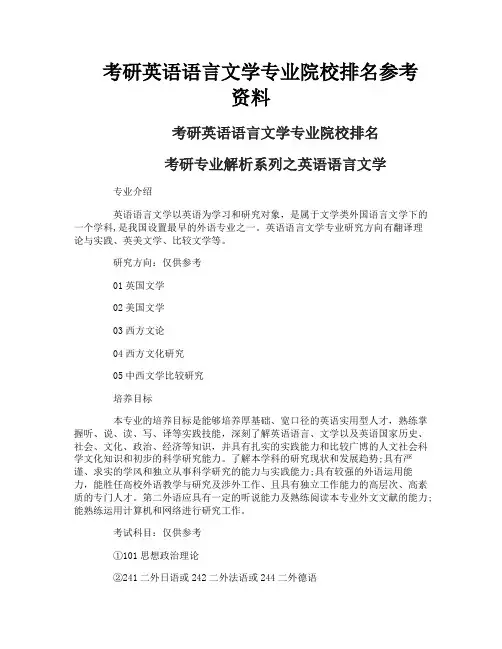
考研英语语言文学专业院校排名参考资料考研英语语言文学专业院校排名考研专业解析系列之英语语言文学专业介绍英语语言文学以英语为学习和研究对象,是属于文学类外国语言文学下的一个学科,是我国设置最早的外语专业之一。
英语语言文学专业研究方向有翻译理论与实践、英美文学、比较文学等。
研究方向:仅供参考01英国文学02美国文学03西方文论04西方文化研究05中西文学比较研究培养目标本专业的培养目标是能够培养厚基础、宽口径的英语实用型人才,熟练掌握听、说、读、写、译等实践技能,深刻了解英语语言、文学以及英语国家历史、社会、文化、政治、经济等知识,并具有扎实的实践能力和比较广博的人文社会科学文化知识和初步的科学研究能力。
了解本学科的研究现状和发展趋势;具有严谨、求实的学风和独立从事科学研究的能力与实践能力;具有较强的外语运用能力,能胜任高校外语教学与研究及涉外工作、且具有独立工作能力的高层次、高素质的专门人才。
第二外语应具有一定的听说能力及熟练阅读本专业外文文献的能力;能熟练运用计算机和网络进行研究工作。
考试科目:仅供参考①101思想政治理论②241二外日语或242二外法语或244二外德语③719基础英语④824英美文学重点学科单位英语语言文学二级国家重点学科:北京大学、北京外国语大学、上海外国语大学、南京大学、湖南师范大学、中山大学、解放军外国语学院院校排名第一档次:北京外国语大学、上海外国语大学、北京大学、南京大学第二档次:湖南师范大学、中山大学、复旦大学、山东大学、厦门大学、华东师范大学、北京师范大学、西南大学、清华大学第三档次:南京师范大学、华中师范大学、浙江大学、东北师范大学、广东外语外贸大学、苏州大学、四川大学、河南大学、福建师范大学、南开大学、四川外语学院、大连外国语学院第四档次:西安外国语大学、中南大学、北京语言大学、上海大学、华中科技大学、天津外国语大学、黑龙江大学、上海交通大学、北京第二外国语学院、陕西师范大学、西北师范大学、湘潭大学、东南大学、华南师范大学、湖南大学、安徽大学、吉林大学、安徽师范大学、上海海事大学、郑州大学、辽宁大学、上海师范大学、中国人民大学、广西师范大学、山东师范大学、江西师范大学、四川师范大学、上海对外贸易学院、西北大学、武汉大学、河北师范大学、首都师范大学、暨南大学、辽宁师范大学、山西大学、河北大学、广西大学、深圳大学等。

专八语言集锦(05年——14年专八真题及解析归纳)目录1、2005年 (1)2、2006年 (2)3、2007年 (4)4、2008年 (6)5、2009年 (8)6、2010年 (10)7、2011年 (11)8、2012年 (12)9、2013年 (13)10、2014年 (14)11、附加语言学考研题 (15)2005年38.(考查点:main branches of linguistics) Syntax is the study ofA. language functionsB. sentence structuresC. textual organizationD.word formation答案:B。
解析:Syntax is about principles of forming and understanding correct English sentences,是关于形成和理解正确英语句子的原则。
也就是句子结构。
故选择B。
39.(考察点:design features of language) Which of ale following is NOTa distinctive feature of human language?A. ArbitrarinessB. ProductivityC. Cultural transmissionD. Finiteness答案:D。
解析:题问下面四个选项中,哪一个不是人类语言的主要特征?除Finiteness(有限性)外,选项中的其它的三项Arbitrariness(任意性),Productivity(能产性)和Cultural transmission(文化传递性)在语言学概述部分都提到了。
故选择D。
40. (考察点:人物)The speech act theory was first put forward byA. John SearleB. John AustinC. Noam ChomskyD. M.A,K. Halliday答案:B。
1.3考研真题与典型题详解I. Fill in the blanks. 1. The features that define our human languages can be called ______ features. (北二外2006研)2. Linguistics is usually defined as the ______study of language. (北二外2003研)3. Language, broadly speaking, is a means of______ communication.4. In any language words can be used in new ways to mean new things and can be combined into innumerable sentences ba sed on limited rules. This feature is usually termed______5. Linguistics is the scientific study of______.6. Modern linguistic is______ in the sense that the linguist tries to discover what language is rather than lay down some rul es for people to observe.7. One general principle of linguistic analysis is the primacy of ______ over writing.8. The branch of linguistics which studies the sound patterns of a language is called ______. (北二外2003研)9. The branch of grammar which studies the internal structure of words is called______. (北二外2004研)10. ______mainly studies the characteristics of speech sounds and provides methods for their description, classification and transcription. (北二外2005研)11. Semantics and ______investigate different aspects of linguistic meaning. (北二外2007研)12. In linguistics, ______ refers to the study of the rules governing the way words are combined to form sentences in a lang uage, or simply, the study of the formation as sentence. (中山大学2008研)13. ______can be defined as the study of language in use. Sociolinguistics, on the other hand, attempts to show the relations hip between language and society.14. The branch of grammar which studies the internal structure of sentence is called _______. (北二外2008研)15. Saussure distinguished the linguistic competence of the speaker and the actual phenomena or data of linguistics (utteran ces) as and . The former refers to the abstract linguisticlinguistic system shared by all the members of a speech community, and the latter is the concrete manifestation of language either through speech or through writing. (人大2006研)16. The description of a language as it changes through time is a ______ study.17. Linguistic potential is similar to Saussure’s langue and Cho msky’s______.18. One of the important distinctions in linguistics is ______ and parole. The former is the French word for “language”, whi ch is the abstract knowledge necessary for speaking,listening,writing and reading. The latter is concerned about the actual use of language by people in speech or writing. Parole is more variable and may change according to contextual factors.19. One of the important distinctions in linguistics is and performance. (人大2006研)20. Chomsky initiated the distinction between ______ and performances. (北二外2007研)II. Multiple Choice1.Which of the following is NOT a frequently discussed design feature? (大连外国语学院2008研)A. ArbitrarinessB. ConventionC. Duality2.Which of the following words is entirely arbitrary? (西安交大2008研)A. treeB. crashC. typewriterD. bang3. A linguist regards the changes in language and languages use as______.A. unnaturalB. something to be fearedC. naturalD. abnormal4. Which of the following property of language enables language users to overcome the barriers caused by time and place, d ue to this feature of language, speakers of a language are free to talk about anything in any situation? A. Transferability.B. Duality.C. Displacement.D. Arbitrariness:5. The study of physical properties of the sounds produced in speech is closely connected with______. (大连外国语学院2008研)A. articulatory phoneticsB. acoustic phoneticsC. auditory phonetics6. Which of the following statements is true of Jacobson’s framework of language functions?A. The referential function is to indulge in language for its own sake.B. The emotive function is to convey message and inf ormation.C. The conative function is to clear up intentions, words and meanings.D. The phatic function is to establish communion w ith others.7.Which of the following is a main branch of linguistics? (大连外国语学院2008研)A. MacrolinguisticsB. PsycholinguisticsC. Sociolinguistics8. ______ refers to the system of a language, i. e. the arrangement of sounds and words which speakers of a language have a shared knowledge of. (西安外国语学院2006研)A. LangueB. CompetenceC. Communicative competenceD. Linguistic potential9.The study of language at one point in time is a _______ study. (北二外2010研)A. historicalB. synchronicC. descriptiveD. diachronic10. “An refer to Confucius even though he was dead 2,000 years ago. ” This shows that language has the design feature of _ ____.A. arbitrarinessB. creativityC. dualityD. displacement11. The function of the sentence “Water boils at 100 degree Centigrade” is .A. interrogativeB. directiveC. informativeD. performative 12.Saussure is closely connected with______. (大连外国语学院2008研) A. Langue B. Competence C. EticIII. True or False1. Onomatopoeic words can show the arbitrary nature of language. (清华2000研)2. Competence and performance refer respectively to a language user’s underlying knowledge about the system of rules and the actual use of language in concrete situations.3. Language is a means of verbal communication. Therefore, the communication way used by the deaf-mute is not language4. Arbitrariness of language makes it potentially creative, and conventionality of language makes a language be passed from generation to generation. As a foreign language learner, the latter is mere important for us.5. The features that define our human languages can be called DESIGN FEATURES. (大连外国语学院2008研)6. By diachronic study we mean to study the changes and development of language.7. Langue is relatively stable and systematic while parole is subject to personal and situational constraints.8. Language change is universal, ongoing and arbitrary.9. In language classrooms nowadays the grammar taught to students is basically descriptive, and more attention is paid to the developing learners’ communicative skills.10. Language is a system of arbitrary, written signs which permit all the people in a given culture, or other people who have learned the system of that culture, to communicate or interact.11. Saussure’s exposition of synchronic analysis led to the school of historical linguistics.12. Applied linguistics is the application of linguistic principles and theories to language teaching and learning.13. Wherever humans exist, language exists. (对外经贸2006研)14. Historical linguistics equals to the study of synchronic study.15. Duality is one of the characteristics of human language. It refers to the fact that language has two levels of structures: the system of sounds and the system of meanings.16. Prescriptive linguistics is more popular than descriptive linguistics, because it can tell us how to speak correct language. IV. Explain the following terms.1.Duality (北二外2010研;南开大学2010研)2.Design featurespetence4.Displacement (南开大学2010研;清华2001研)5.Diachronic linguistics6. Descriptive linguistics7.Arbitrariness(四川大学2006研)V. Short answer questions1. Briefly explain what phonetics and phonology are concerned with and what kind of relationships hold between the two. (北外2002研)参考答案及解析I.Fill in the blanks.1.Design (人类语言区别于其他动物交流系统的特点是语言的区别特征,是人类语言特有的特征。
英语语言文学考研书目以下是一些英语语言文学考研书目的推荐:1.《英语国家文化与社会》(A Companion to Contemporary Britain: 1939-2000),By: Paul Addison 和 Harriet Jones这本书主要讲述了英国社会和文化的历史,对于理解英国历史背景和文化环境非常有帮助。
2.《现代英语语法》(A Student's Introduction to English Grammar),By: Rodney Huddleston 和 Geoffrey K. Pullum这本书是英语语法的经典教材,对于英语语言学习和理解英语语法规则非常有帮助。
3.《英美文学概论》(An Introduction to English and American Literature),By: Richard Jacovitz这本书涵盖了英美文学的主要作品和流派,是考研英语语言文学专业必备的教材。
4.《英语语言学原理》(An Introduction to Linguistics),By: Adrian Akmajian, Richard A. Demers, Ann K. Farmer 和 Robert M. Harnish这本书介绍了语言学的基本原理和方法,对于理解英语语言学的概念和理论非常重要。
5.《英美文学史》(A History of English Literature),By: Michael Alexander这本书详细介绍了英国和美国文学的发展历程和主要作品,对于考研英语语言文学专业非常有帮助。
6.《英语写作与修辞》(The Craft of Research),By: Wayne C. Booth, Gregory G. Colomb, Joseph M. Williams 和 Joseph Bizup 这本书教授了英语写作和修辞的技巧和方法,对于提高写作水平非常有帮助。
学科教育(英语)研究生40本必读书目一、语言学及应用语言学(共22本)1.Aronoff, M. et al (eds): The Handbook of Linguistics2.Robins, R. H. General Linguistics (Fourth Edition)3.Saussure, F. D. Course in General Linguistics4.Clark, J. et al. An Introduction to Phonetics and Phonology5.Radford, A. Syntax: A Minimalist Introduction6.Lyons, J. Linguistic Semantics: an Introduction7.Saeed, J. I. Semantics8.Mathews, P. H. Morphology (Second Edition)9.Levinson, S.C. Pragmatics10.Gee, J. P. an Introduction to Discourse Analysis: Theory and Method11.Searle, J. R. Speech Acts: An Essay in the Philosophy of Language12.Ungerer, F. et al An Introduction to Cognitive Linguistics认知语言学入门13.Halliday, M. A. K. An Introduction to Functional Grammar (SecondEdition)功能语法导论14.Biber, D et al Corpus Linguistics语料库语言学15.First Language Acquisition第一语言习得16.Cook, V. Second Language Learning and Language Teaching (SecondEdition)第二语言学习与教学17.James, C. Errors in Language Learning and Use: Exploring ErrorAnalysis语言学习和语言使用中的错误:错误分析探讨rsen-Freeman, D. et al An Introduction to Second LanguageAcquisition Research第二语言习得研究概况19.Nunan, D. Second Language Teaching and Learning第二语言教与学20.Reid, J. M. Learning Styles in the ESL/EFL Classroom ESL/EFL英语课堂上的学习风格21.Alderson, J. C. et al Language Test Construction and Evaluation语言测试的设计与评估22.Yalden, J. Principles of Course Design for Language Teaching语言教学课程设计原理二、翻译(共10本)1.Nida, E.A. Toward a Science of Translating. Leaden: E.J. Brill. 19642.Nida, E.A.&Taber,C.R. The Theory and Practice of Translation. Leaden:E.J. Brill. 19693.Newmark Peter, Approaches to Translation, Oxford: Pergamon, 上海外语教育出版社,19824.Gentzler, Edwin, Contemporary Translation Theories, 上海:上海外语教育出版社,20065.Gile, D. Basic Concepts and Models for Interpreter and TranslatorTraining, Amsterdam & Philadelphia: John Benjamins Publishing Company, 19956.Franz, Pochhacker, Introducing Interpreting Studies, London and NewYork: Routledge, 20047.谭载喜,《西方翻译简史》,北京:商务印书馆,19918.陈福康,《中国译学理论史稿》,上海外语教育出版社,20009.刘宓庆,《当代翻译理论》,中国对外翻译出版公司,199910.连淑能,《英汉对比研究》,高等教育出版社,1993三、文学文化(共8本)1.朱刚,《二十世纪西方文艺批评理论》(英文版),上海外语教育出版社,20012.左金梅,《当代西方文论》(Modern Western Literary Theory and Criticism)(第二版)(英文版)中国海洋大学出版社,20113.孙有中,《西方思想经典导读》(英文版),外语教学研究,20084.马新国主编,《西方文论史》(中文版)(修订版),高等教育出版社,20035.王宪生,《西方文化》(Western Culture),(英文版)河南人民出版社,20106.陆道夫,《西方文化英文选读》,(英文版)暨南大学出版社, 20087.张中载,《西方古典文论选读》(英文版),外语教学与研究,20068.王立等,《生态美学视野中的中外文学作品》,人民文学出版社,2007附1:主要专业学术期刊(国内)1、Journal of Cross Cultural Psychology2、Modern Language Journal3、Language Learning and Communication4、European Journal of Teacher Education5、Journal of Multicultural Counseling and Development6、外语教学与研究7、外国语8、现代外语9、外语界10、外语与外语教学11、外语教学12、解放军外语学院学报13、外语研究14、中国翻译15、中国外语15、上海翻译16、中国科技翻译17、外语学刊18. 外国语文(原:四川外语学院学报)19. 天津外国语大学学报20. 外国语言文学(原:福建外语)21. 山东外语教学附2:主要专业学术期刊(国际)SSCI Journals --- Language, Linguistics and TESOL1. ACROSS LANGUAGES AND CULTURES Semiannual ISSN: 1585-1923AKADEMIAI KIADO RT, PRIELLE K U 19, PO BOX 245,, BUDAPEST,HUNGARY, H-11171. Social Sciences Citation Index2. Arts & Humanities Citation Index2. BILINGUALISM-LANGUAGE AND COGNITION Tri-annual ISSN:1366-7289CAMBRIDGE UNIV PRESS, 32 AVENUE OF THE AMERICAS, NEW YORK, USA, NY, 10013-24731. Social Sciences Citation Index2. Current Contents - Social & Behavioral Sciences3. CANADIAN MODERN LANGUAGE REVIEW-REVUE CANADIENNE DES LANGUES VIVANTES Quarterly ISSN: 0008-4506CANADIAN MODERN LANGUAGE REV, UNIV TORONTO PRESS,JOURNALS DIVISION, 5201 DUFFERIN ST,, N YORK, CANADA,ONTARIO, M3H 5T8Social Sciences Citation Index4. FOREIGN LANGUAGE ANNALS Quarterly ISSN: 0015-718XWILEY-BLACKWELL PUBLISHING, INC, COMMERCE PLACE, 350 MAIN ST, MALDEN, USA, MA, 021481. Social Sciences Citation Index2. Current Contents - Social & Behavioral Sciences5. JOURNAL OF FRENCH LANGUAGE STUDIES Tri-annual ISSN: 0959-2695CAMBRIDGE UNIV PRESS, EDINBURGH BLDG, SHAFTESBURY RD,CAMBRIDGE, ENGLAND, CB2 8RU1. Social Sciences Citation Index2. Arts & Humanities Citation Index6. JOURNAL OF LANGUAGE IDENTITY AND EDUCATION Quarterly ISSN: 1534-8458ROUTLEDGE JOURNALS, TAYLOR & FRANCIS LTD, 4 PARK SQUARE,MILTON PARK, ABINGDON, ENGLAND, OXFORDSHIRE, OX14 4RN1. Social Sciences Citation Index2. Arts & Humanities Citation Index7. JOURNAL OF PIDGIN AND CREOLE LANGUAGES Semiannual ISSN: 0920-9034JOHN BENJAMINS PUBLISHING COMPANY, PO BOX 36224,AMSTERDAM, NETHERLANDS, 1020 ME1. Social Sciences Citation Index2. Arts & Humanities Citation Index3. Current Contents - Social & Behavioral Sciences4. Current Contents - Arts & Humanities8. LANGUAGE Quarterly ISSN: 0097-8507LINGUISTIC SOC AMER, 1325 18TH ST NW, SUITE 211, WASHINGTON, USA, DC, 20036-65011. Social Sciences Citation Index2. Arts & Humanities Citation Index3. Current Contents - Social & Behavioral Sciences4.Current Contents - Arts & Humanities9. LANGUAGE & COMMUNICATION Quarterly ISSN: 0271-5309PERGAMON-ELSEVIER SCIENCE LTD, THE BOULEVARD, LANGFORDLANE, KIDLINGTON, OXFORD, ENGLAND, OX5 1GB1. Social Sciences Citation Index2. Current Contents - Social & Behavioral Sciences10. LANGUAGE ACQUISITION Quarterly ISSN: 1048-9223PSYCHOLOGY PRESS, 27 CHURCH RD, HOVE, ENGLAND, EAST SUSSEX, BN3 2FA1. Social Sciences Citation Index2. Arts & Humanities Citation Index11. LANGUAGE AND COGNITIVE PROCESSES Bimonthly ISSN: 0169-0965PSYCHOLOGY PRESS, 27 CHURCH RD, HOVE, ENGLAND, EAST SUSSEX, BN3 2FA1. Social Sciences Citation Index2. Current Contents - Social & Behavioral Sciences3. BIOSIS Previews12. LANGUAGE AND INTERCULTURAL COMMUNICATION Quarterly ISSN: 1470-8477ROUTLEDGE JOURNALS, TAYLOR & FRANCIS LTD, 4 PARK SQUARE,MILTON PARK, ABINGDON, ENGLAND, OXFORDSHIRE, OX14 4RN1. Social Sciences Citation Index2. Arts & Humanities Citation Index13. LANGUAGE AND LINGUISTICS Quarterly ISSN: 1606-822XINST LINGUISTICS ACAD SINICA, NO 130, SEC 2, ACADEMIA RD,NANKANG, TAIPEI, TAIWAN, 115291. Social Sciences Citation Index2. Arts & Humanities Citation Index3. Current Contents - Arts & Humanities14. LANGUAGE AND LITERATURE Quarterly ISSN: 0963-9470SAGE PUBLICATIONS LTD, 1 OLIVERS YARD, 55 CITY ROAD, LONDON, ENGLAND, EC1Y 1SP1. Social Sciences Citation Index2. Arts & Humanities Citation Index15. LANGUAGE AND SPEECH Quarterly ISSN: 0023-8309KINGSTON PRESS SERVICES LTD, 43, DERWENT RD, WHITTONTWICKENHAM, MIDDLESEX, ENGLAND, TW2 7HQ1. Social Sciences Citation Index2. Current Contents - Social & Behavioral Sciences16. LANGUAGE ASSESSMENT QUARTERLY Quarterly ISSN: 1543-4303ROUTLEDGE JOURNALS, TAYLOR & FRANCIS LTD, 4 PARK SQUARE, MILTON PARK, ABINGDON, ENGLAND, OXFORDSHIRE, OX14 4RN1. Social Sciences Citation Index2. Arts & Humanities Citation Index3. Current Contents - Social & Behavioral Sciences4. Current Contents - Arts & Humanities17. LANGUAGE AWARENESS Quarterly ISSN: 0965-8416ROUTLEDGE JOURNALS, TAYLOR & FRANCIS LTD, 4 PARK SQUARE, MILTON PARK, ABINGDON, ENGLAND, OXFORDSHIRE, OX14 4RN1. Social Sciences Citation Index2. Arts & Humanities Citation Index18. LANGUAGE CULTURE AND CURRICULUM Tri-annual ISSN: 0790-8318ROUTLEDGE JOURNALS, TAYLOR & FRANCIS LTD, 4 PARK SQUARE, MILTON PARK, ABINGDON, ENGLAND, OXFORDSHIRE, OX14 4RN1. Social Sciences Citation Index2. Arts & Humanities Citation Index19. LANGUAGE IN SOCIETY Bimonthly ISSN: 0047-4045CAMBRIDGE UNIV PRESS, 32 AVENUE OF THE AMERICAS, NEW YORK, USA, NY, 10013-24731. Social Sciences Citation Index2. Current Contents - Social & Behavioral Sciences20. LANGUAGE LEARNING Quarterly ISSN: 0023-8333WILEY-BLACKWELL PUBLISHING, INC, COMMERCE PLACE, 350 MAIN ST, MALDEN, USA, MA, 021481. Social Sciences Citation Index2. Current Contents - Social & Behavioral Sciences21. LANGUAGE LEARNING & TECHNOLOGY Tri-annual ISSN: 1094-3501UNIV HAWAII, NATL FOREIGN LANGUAGE RESOURCE CENTER, 1859 EAST WEST RD, 106, HONOLULU, USA, HI, 968221. Social Sciences Citation Index2. Current Contents - Social & Behavioral Sciences22. LANGUAGE MATTERS Semiannual ISSN: 1022-8195ROUTLEDGE JOURNALS, TAYLOR & FRANCIS LTD, 4 PARK SQUARE,MILTON PARK, ABINGDON, ENGLAND, OXFORDSHIRE, OX14 4RN1. Social Sciences Citation Index2. Arts & Humanities Citation Index23. LANGUAGE PROBLEMS & LANGUAGE PLANNING Tri-annual ISSN: 0272-2690JOHN BENJAMINS PUBLISHING COMPANY, PO BOX 36224,AMSTERDAM, NETHERLANDS, 1020 ME1. Social Sciences Citation Index2. Arts & Humanities Citation Index24. LANGUAGE SCIENCES Bimonthly ISSN: 0388-0001ELSEVIER SCI LTD, THE BOULEVARD, LANGFORD LANE, KIDLINGTON, OXFORD, ENGLAND, OXON, OX5 1GB1. Social Sciences Citation Index2. Arts & Humanities Citation Index3. Current Contents - Social & Behavioral Sciences4. Current Contents - Arts & Humanities25. LANGUAGE TEACHING Quarterly ISSN: 0261-4448CAMBRIDGE UNIV PRESS, EDINBURGH BLDG, SHAFTESBURY RD,CAMBRIDGE, ENGLAND, CB2 8RU1. Social Sciences Citation Index2. Arts & Humanities Citation Index26. LANGUAGE TEACHING RESEARCH Quarterly ISSN: 1362-1688SAGE PUBLICATIONS LTD, 1 OLIVERS YARD, 55 CITY ROAD, LONDON, ENGLAND, EC1Y 1SP1. Social Sciences Citation Index27. LANGUAGE TESTING Quarterly ISSN: 0265-5322SAGE PUBLICATIONS LTD, 1 OLIVERS YARD, 55 CITY ROAD, LONDON, ENGLAND, EC1Y 1SP1. Social Sciences Citation Index2. Arts & Humanities Citation Index28. COGNITION Monthly ISSN: 0010-0277ELSEVIER SCIENCE BV, PO BOX 211, AMSTERDAM, NETHERLANDS,1000 AE1. Social Sciences Citation Index2. Current Contents - Social & Behavioral Sciences3. BIOSIS Previews29. COGNITION AND INSTRUCTION Quarterly ISSN: 0737-0008LAWRENCE ERLBAUM ASSOC INC-TAYLOR & FRANCIS, 325CHESTNUT STREET, STE 800, PHILADELPHIA, USA, PA, 191061. Social Sciences Citation Index2. Current Contents - Social & Behavioral Sciences30. COGNITIVE AND BEHAVIORAL PRACTICE Semiannual ISSN: 1077-7229ELSEVIER SCIENCE INC, 360 PARK AVE SOUTH, NEW YORK, USA, NY, 10010-17101. Social Sciences Citation Index2. Current Contents - Social & Behavioral Sciences31. COGNITIVE DEVELOPMENT Quarterly ISSN: 0885-2014ELSEVIER SCIENCE INC, 360 PARK AVE SOUTH, NEW YORK, USA, NY, 10010-17101. Social Sciences Citation Index2. Current Contents - Social & Behavioral Sciences32. COGNITIVE LINGUISTICS Quarterly ISSN: 0936-5907MOUTON DE GRUYTER, GENTHINER STRASSE 13, BERLIN, GERMANY, 107851. Social Sciences Citation Index2. Arts & Humanities Citation Index3. Current Contents - Social & Behavioral Sciences4. Current Contents - Arts & Humanities33. COGNITIVE PROCESSING Quarterly ISSN: 1612-4782SPRINGER HEIDELBERG, TIERGARTENSTRASSE 17, HEIDELBERG,GERMANY, D-691211. Social Sciences Citation Index2. Current Contents - Social & Behavioral Sciences34. COGNITIVE PSYCHOLOGY Quarterly ISSN: 0010-0285ACADEMIC PRESS INC ELSEVIER SCIENCE, 525 B ST, STE 1900, SANDIEGO, USA, CA, 92101-44951. Science Citation Index Expanded2. Social Sciences Citation Index3. Current Contents - Social & Behavioral Sciences35. COGNITIVE SYSTEMS RESEARCH Quarterly ISSN: 1389-0417ELSEVIER SCIENCE BV, PO BOX 211, AMSTERDAM, NETHERLANDS,1000 AE1. Science Citation Index Expanded2. Social Sciences Citation Index3. Current Contents - Social & Behavioral Sciences4. Current Contents - Engineering, Computing & Technology 36. COGNITIVE THERAPY AND RESEARCH Bimonthly ISSN: 0147-5916SPRINGER/PLENUM PUBLISHERS, 233 SPRING ST, NEW YORK, USA, NY, 100131. Social Sciences Citation Index2. Current Contents - Social & Behavioral Sciences3. BIOSIS Previews37. TESOL QUARTERLY Quarterly ISSN: 0039-8322TESOL, 700 SOUTH WASHINGTON ST, STE 200, ALEXANDRIA, USA, VA, 22314Social Sciences Citation Index38. ANNUAL REVIEW OF APPLIED LINGUISTICS Annual ISSN: 0267-1905CAMBRIDGE UNIV PRESS, 32 AVENUE OF THE AMERICAS, NEW YORK, USA, NY, 10013-24731. Social Sciences Citation Index2. Arts & Humanities Citation Index。
英语语言文学考研书目
英语语言文学考研书目包括以下几本:
1. 《英国文学简史》(刘炳善):这本书系统介绍了英国文学的发展历程,从古代到现代,涵盖了各个时期的主要作家和作品。
2. 《美国文学简史》(常耀信):本书以编年的方式,对美国文学进行了全面梳理,内容丰富,叙述详实。
3. 《英国文学史及选读》(吴伟仁):这本书分为两册,上册侧重文学史的介绍,下册则是作品选读,帮助考生深入了解英国文学的经典作品。
4. 《新编简明英语语言学教程》(戴炜栋):本书介绍了英语语言学的基本概念和理论,是英语语言学考研的必备教材之一。
5. 《语言学教程》(胡壮麟):这本书系统介绍了语言学的基本概念和理论,是语言学考研的经典教材之一。
6. 《英汉翻译教程》(张培基):这本书介绍了英汉翻译的基本理论和技巧,是英汉翻译考研的必备教材之一。
7. 《英译中国现代散文诗》(张培基):这是一本翻译实践类的教材,收录了多篇中国现代散文诗的英文译本,有助于提高翻译水平。
8. 《英汉对比研究》(连淑能):这本书对比了英汉两种语言的语法、词汇、句法等方面的异同,有助于深入了解英汉语言的差异。
此外,还有《美国文学选读》、《英国文学选读》、《语言学高级教程》、《英汉翻译教程》等也是英语语言文学考研的常用教材。
全国硕士研究生入学统一考试英语语言学及英汉互译考试大纲一、考试要求掌握普通语言学的基本概念、基础理论,并能运用理论进行简单的语言结构分析。
有较扎实的语言功底,较强的英汉书面表达能力,掌握并灵活运用常用英汉翻译技巧。
二、考试内容1、普通语言学的定义及主要分支;2、语言的性质:语言、语言的特征、语言的功能;3、语音学(phonetics)中的基本术语;4、语素、词缀及主要构词法;5、句法结构分析;6、语义关系及语义成分分析;7、言语行为理论和会话涵义理论;8、现代语言学的主要理论和流派;9、英译汉;10、汉译英。
三、题型Section A1、术语解释(20分:10题)2、填空(20分:20题)3、简答(30分:6题)4、详答(20分:1题)Section B1、英译汉(30分:一个约250单词的段落)2、汉译英(30分:一个约250字的段落)四、参考书胡壮麟主编.《语言学教程》(修订版).北京大学出版社,2002年冯庆华.《实用翻译教程》(第一版).上海外语教育出版社,2002年五、题型示例及参考答案Section APart I. Define the following terms briefly (20 points, 2 points each).1. Displacement2. MetalanguagePart II. Fill the blanks with proper words (20 points , 1 point each blank).1. By _____ is meant the property of having two levels of structures, such that units of the primary level are composed of elements of the secondary level and each of the two levels has its own principles of organization.2.____ studies the rules governing the structure , distribution, and sequencing of speech sounds and the shape of syllables.Part III. Answer the following questions briefly(30 points, 4 points each).1.Do you think that onomatopoeia indicates a non-arbitrary relationship between form and meaning?2. To what extent is phonology related to phonetics and how do they differ?Part IV. Give a detailed description of the special features of American structuralism(20 points). Section BPart I. E-C Translation (30 points)What social morality and social conscience leaves out is the narrower but very significant concept of honor------as opposed to what is sometimes called merely “socially desirable conduct.” The man of honor is not content to ask merely whether this or that will hurt society, or whether it is what most people would permit themselves to do. He asks, and he asks first of all, would it hurt him and his selfrespect? Would it hishonor him personally? It was a favorite and no doubt sound argument among early twentieth-century reformers that “playing the game” as the gentleman was supposed to play it was not enough to make a decent society. They were right: it is not enough. But the time has come to add that it is nevertheless indispensable. I hold that it is indeed inevitable that the so-called social conscience unsupported by the concept of personal honor will create a corrupt society. But suppose that it doesn’t. Suppose that no one except the individual suffers from the fact that he sees nothing wrong in doing what everybody else does. Even so, I still insist thatfor the individual himself nothing is more important than this personal, interior sense of right and wrong and his determination to follow that rather than to be guided by that everybody does or merely the criterion of “social usefulness.”It is impossible for me to imagine a good society composed of men without honor.Part II. C-E Translation (30 points)他在父亲的教导下“发愤用功”,其实他读书还是出于喜好,只似馋嘴佬贪吃美食:食肠很大,不择精粗,甜咸杂进。
江苏大学 2004 年考研试题 I. Multiple choice (10%) 1. __________ has been widely accepted as the forefather of modern linguistics. a. Chomsky b. Saussure c. Bloomfield d. John Lyons 2. The minimal independent unit of language is ______ . a. phoneme b. word c. morpheme d. affix 3. __________ is not an English consonant. a. Labio-dental plosive b. Alveolar nasal c. velar stop d. Dental 4. ________ is not a distinctive feature in English phonology. a. Nasality b. Voicing c. Aspiration d. rounding 5. The choice of an allophone in a given phonetic context is ____ .6. Site and sight are7. Kodak is a(n) a. coinage b. blending c. acronym is a phenomenon that in some speech communities two varieties of a language exist sides by side, with each having a different role to play.9. The Indirect Speech Act was developed by10. The totality of linguistic varieties possessed by an individual constitutes hisfricative a. random b. predictable c. variable d. independent a. orthography b. homography c. homophony d. hyponymy d. clipping 8. a. Bilingu b. Diglossia c. Pidgin d. Creole a. John Austinb. Levinsonc. John Lyonsd. John Searle.a. registerb. linguistic repertoirec. idiolectd. dialectDefine the following terms(30%)3. competence4. manners of articulation language 14. illocutionary act authorityIII. Justify the following claims or statements. (20%)1 The violation of one or more of the conversational maxims (of the CPPrinciple) can, when the listener fully understands the speaker, create conversational implicature, a humor sometimes.2Duality and cultural transmission are two most important design features of human language.3. Chomsky's 'competence' and 'performance' are similar in meaning to Saussure's 'langue' and 'parole'.IV. Make your critical remarks on the following: (20% ):1 It's a bit cold in here.2 John married Fred's sister3 He drank another glass of beer4 The lecturer continued speaking.5 Peter has stopped beating his wifeV. Give one concept to cover the following statement (6%) 1) Humanlanguage can be used to refer to real or imagined matters in the past, present, or future. It can even be used to talk about language itself.2) A competent native speaker is able to utter any grammatical sentence that he has never said before or understand any that he has never heard before.3) Chomsky believes that anyone who knows a language has internalized a set of rulesII. 1. arbitrariness 2. evocative 5. distinctive features 6. stem 7. idiom8. endocentric9. hyponymy10. sound writing 11. acronym 12. ideolectabout the sequences permitted in his language.4) Chomsky is much interested in the study of the similarities between languages rather than their differences.5) Roughly from 1930 to 1960 some linguists gave pre-eminence to the empirical or observational aspect in their investigation of meaning. They believed the meaning of a word is its use in the language.6) Since 1960's, some modern linguists have viewed the primary function of language as the communication of ideas and assumed the data needed about language can be supplied by direct resort to intuition.VI. Answer the following questions briefly (20%)1. Do you prefer descriptive linguistics to prescriptive linguistics Give your reasons.2. What is the difference between broad transcription and narrow transcription3. How is a phoneme different from a speech sound4. Why is speech prior to writing5. Why can ' t we do away with Chinese charactersVII. For each of the underlined constructions or word groups, do the following: (8%)a. State whether it is headed or non-headed.b. If non-headed, state its headword.c. Name the type of constructions.1. Ducks quack.2. I saw a bridge damaged beyond repair.3. He enjoys climbing high mountains4. His handsome face appeared in the magazine.' s theory of meaning. (16%)VIII. Give a detailed description of Firth(20%) IX. Give an overall account of the relationship between language and culture.。
语言学考试大纲一、考查目标语言学考试旨在科学、公平、有效地测试考生对语言基本知识和主要理论的掌握程度,确保英语专业硕士研究生的入学质量。
考生需要系统掌握语言学的基本理论、基本知识和语言学研究的基本方法,能够初步运用所学的基本理论、基本知识和基本方法分析判断分析与语言相关的理论问题和实际问题。
二、考试形式、试卷结构答题方式为闭卷、笔试。
三、试卷满分及考试时间本试卷共有五部分组成,满分为150分;第I、II、III部分为客观题,占试卷的7/15;第IV、V、部分为主观题,占试卷的8/15。
考试时间为180分钟。
四、试卷题型及分值I.正误判断题:20道小题,每小题1分,共20分;II.单词填空题:10道小题,每小题1分,共10分;III.单项选择题:40道小题,每小题1分,共40分;IV.简答题:共3-4道小题,共40分;V.论述题:2-3道小题,共40分。
五、考查要点I.考查要点:考查考生语言学基本概念和基本理论的认知程度。
要求考生对给定的陈述进行判断,确定其正确与否。
II.考查要点:考查考生对语言学基本概念和基本理论掌握的准确程度。
要求考生不仅能够理解所提供的内容,而且还能根据提示准确写出关键词。
III.考查要点:考查考生对语言学基本概念、基本理论的理解,也考察考生根据理论对语言现象进行分析的能力。
IV.考查要点:考查考生结合语言学理论对语言现象进行分析的能力。
V.考查要点:首先考查考生对对语言学理论的掌握情况,在此基础上考查考生根据语言学理论对语言学问题进行系统分析的能力。
六、考试范围1. 语言和语言学的基础知识关于语言:语言的定义、起源、特征、功能。
关于语言学:语言学的主要分支学科,宏观语言学。
语言学中一些重要的基本概念:描写与规定、共时与历时、语言和言语、能力与表现。
共济网2. 语音学及音系学知识语音学:语音的发生与感知、发音器官、语音的演变、语音标注、辅音、元音、语音的描写、协同发音。
音系学:音位理论和音位变体、音系规则、区别特征、音节、重音。
3. 词汇学知识词的含义、词的识别、词的分类、词的构成、词的变化。
4. 句法学知识传统语法:性、数、格,时、体,一致关系、支配关系。
结构主义语法:组合关系、聚合关系、直接成分分析法、向心结构、离心结构。
生成语法:深层结构、表层结构、标准理论、支配与约束理论。
功能语法:功能主义的语言观、系统功能语法。
5. 语义学和语用学知识语用学:言语行为理论、会话含义理论、关联理论、霍恩的两原则理论、莱文森的三原则理论。
语义学:“意义”的意义、指称论、涵义关系、成分分析、句子的逻辑语义。
6. 从语言学角度分析文学作品的知识文学语言的基本特征、诗歌语言的特点和分析、小说语言的特点和分析、戏剧语言的特点和分析。
7. 心理语言学和社会语言学知识心理语言学:语言的理解、话语/语篇解释、语言的产生。
社会语言学:萨丕尔-沃尔夫假说、语言变异、双语现象和多语现象、语言民俗学、礼貌原则、标准语和方言、语码选择、语言中的性别歧视。
8. 计算机语言学知识计算机辅助语言学习、机器翻译、语料库语言学、信息检索、网络语言。
9. 教育语言学/外语教学知识不同语言学观点对语言教学的影响、外语教学大纲的设计、语言学习的基本理论、学习者错误分析、语言测试的基本概念和方法。
七、试题示例I.Mark the following statements with “T” if they are true or “F” if they are false 20分1.If we are not fully aware of the nature and mechanism of our language, we will beignorant of what constitutes our essential humanity.2. A phoneme is the smallest unit of sound and cannot be further analyzed.3.Anthropological linguistics refers to the approach which studies language overvarious periods of time and at various historical stages.……II.Fill in each of the following blanks with an appropriate word with the hint of the initial letter (Write complete word forms on your answer sheet). 10分1. 1. The r theory is a theory of meaning which relates the meaning of aword to the real world.2.R is the term used in linguistics to describe the relationship between aparticular style of language and its context of use.3.V is made with the back of the tongue and the soft palate. An example inEnglish is [k] as in cat.……III.M ark the choice that best completes the statement 40分1.______ function constructs a model of experience and logical relations.A. InterpersonalB. TextualC. MetalingualD. Ideational2.___________ is not the term used to classify the English consonants in terms ofmanner of articulation.A. ApproximantB. LateralC. PlosiveD. Bilabial3.In the following word ______, the articulation of bilabial is not manifested.A. pet B .met C. how D. web4.Triphthongal glides in English can be heard in the word .A. tideB. toy C how D. wire……IV. Answer the following questions briefly 40分1. Use your linguistic knowledge of sense relations to explain what makes the following humorous. (10 points)a. Question: Why was Six afraid?Answer: Because Seven Eight Nine.b. Education kills by degrees.2. What design feature/s of language does each of the following language phenomenashow? Explain briefly why you think so. (20 points)a. cir → encircle or circularb. 我感冒了= I have a cold / I caught a cold. (English)= Hargab baa ku haya. (Somali)= Tá slaghdán ort. (Irish)= 나는감기에걸렸다. (Korean)c. 小虎: 妈妈,我昨晚梦见你带我去迪斯尼乐园了。
d. As captain of the plane, Helen took her place in the henpit and started the engine.3. Specify what type/branch of linguistic study will most likely deal with each of the following research questions. (10 points)A.Which lexeme has the highest frequency on the data?B.What factors have brought new words into our daily use of the language?C.Is it possible to use this device to recognize the kidnapper’s voice amongthousands of calls you get every day?D.What are the drawbacks of using logical forms to translate a complex sentence?E.What are the differences between real-world tasks and pedagogical tasks?F.Does the universal quantifier presuppose the existence of an entity named by theargument?G.What factors will cancel the presence of a conversational implicature?H.How does language represent the way human beings perceive and conceptualizethe world?I.Is touchable in the word untouchable a stem or a root with a suffix?J.In what kind of context the production of a sound will be influenced by aneighboring sound?V. Answer the following essay questions1. Use the underlined sentences in the following dialogue as examples to explainthe functions of language. (10 points)Tom: I’ve got an extra ticket for the opera on Saturday. Do you know anyone who might like to go?Mary: Not offhand. But I’ll ask around.Tom: Well, thanksMary: Hey, come to think of it, I’m free! I’d love to go.Tom: Great! Do you mind driving?Mary: Not at all. Pick you up at seven?2. Use your knowledge of morphology to invent a brand name for a pet shampoowhich will be marketed in English speaking countries. Explain your reasons.(10 points)。